| Tags | design and inspiration great outdoors guide fun and interesting cleaning and maintenance garden bridge guide children seating show all posts |
How To Master Growing Herbs In Your Home Or Garden
Herbs offer a great boost of flavour to any dish and can make a dull kitchen space look fresh. There are many benefits to growing these aromatic plants.
Herbs are not only tasty and pretty to look at, but they are also really good for you. Most herbs contain plenty of vitamins and tending after a garden is a great way of exercising while doing something you enjoy.
While herbs aren't the most difficult plants to grow, there are a few key things that you should know about these plants before you begin.

How To Master Growing Herbs
Know what you're growing
Growing herbs is not only useful, but relatively easy to do as well. Herbs can add a lot of flavour and depth to your dishes, with some herbs even helping keep pests away from other plants in your garden.
In order for your herbs to thrive you need to choose a plant that is able to grow in the conditions in your home or garden. We compiled a really useful fact list of the 5 most common household herbs to help make your choice easier.
Oregano
Scientific name: Origanum vulgare
This fragrant herb is really easy to grow and will fill your home or garden with wonderful aromas
-
Plant it in light soil and don't fertilise it. This plant actually prefers growing in moderately fertile soil.
-
It can perform well in a partially sunny environment although the flavour is more intense if it receives plenty of sunlight.
-
This plant requires adequate heat in order to grow. Plant the seeds outdoor 6-7 weeks before first frost.
-
Don't over water! Water thoroughly only when soil is dry to touch.
-
Plant oregano about 10” apart.
-
Average Height: up to 2 feet tall
-
Gets along with most other plants. We suggest planting it alongside peppers or tomatoes because it helps keep some pests away.
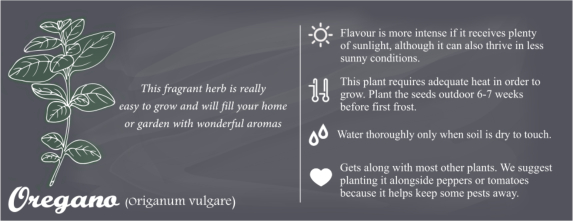
Oregano
Parsley
Scientific name: Umbelliferae
This common herb is so much more than just a pretty garnish. It is an excellent source of Vitamins K, A & C as well as iron.
-
Plant in moist, rich soil, but choose an area that is weed-free because this plant is a slow starter and you will only be able to see the seedlings after about 3 weeks.
-
Water the seeds really often as they germinate to prevent them from drying. The mature plant is adaptable and is relatively tolerant to droughts.
-
This plant does well in partially sunny environments, but for best results keep parsley near a sunny window.
-
Plant parsley approximately 9” apart, although this plant does really well in pots.
-
Average height: up to 1 ½ feet tall
-
Plant parsley nearby roses in your garden. This helps keep your roses healthy and fragrant.
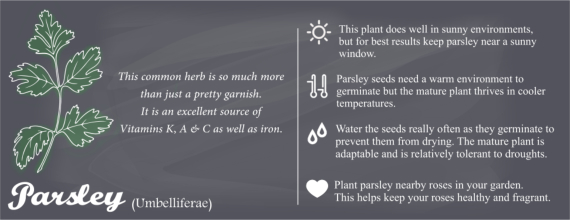
Parsley
Thyme
Scientific name: Thymus
This plant is not only beautiful to look at, but it brings flavour and depth to many delicious recipes.
-
Plant in well drained soil and fertilise using compost in early-mid Spring. Don't over-fertilise the soil.
-
Thyme is also relatively drought-resistant so you only need to water it when the soil feels dry to the touch.
-
This plant needs plenty of sunlight in order to thrive.
-
Because it is definitely a grower, thyme needs plenty of space. The recommended average spacing between plants should be about 12”-14”.
-
Average height: 6”-12”
-
It is a good idea to plant thyme alongside rosemary because both herbs have similar watering requirements.
-
It is advisable to plant young thyme plants about three weeks before the last frost in order for them to grow strong roots. Mature plants can thrive in warm environments and are drought-resistant.
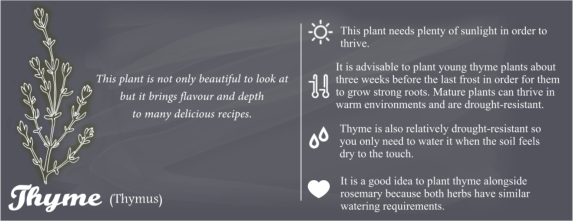
Thyme
Basil
Scientific name: Ocimum basilicum
Basil is a staple in many cuisines and adds a fresh, intense flavour to many of your favourite dishes.
-
Basil is very sensitive to cold temperature so it might be advisable to bring it indoors as the weather changes.
-
Plant six weeks before the last frost and keep covered if necessary.
-
Basil is easy to grow and can even root if a section of the plant is put in water. Simply cut a 4”-5” section of the plant (make sure it hasn't flowered yet) and place it in a cup of clear water. Roots should be visible in about one week. You can plant the newly rooted basil when the roots grow a little bit more.
-
This plant loves sunlight and thrives in sunny environments where it can receive around six hours of sunlight per day.
-
Water when the soil is dry to the touch. Avoid watering the leaves and focus instead on watering around its base.
-
Average height: 12”-24”.
-
Basil is a fast growing plant that can easily overwhelm other plants around it if left to its own devices. Aim to plant basil about 16” apart for optimal growth. However, if you are limited by space basil does extremely well in containers as well.
-
Plant alongside tomatoes and parsley because they have similar watering needs.
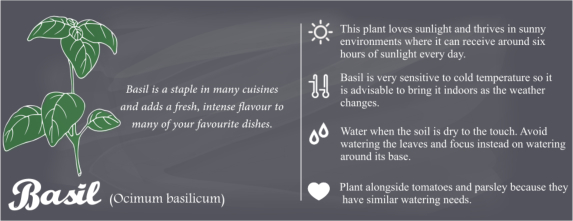
Basil
Mint
Scientific name: Mentha
This extremely versatile plant is very resilient and adds a touch of something special to any dish you add it to.
-
This plant grows well in both warm and cool environments and is adaptable to temperature changes.
-
For best results it is recommended to grow mint in very sunny environments but it can also survive in places with less sunlight.
-
Be careful when planting mint in your garden because it is considered an invasive species and it will spread quickly. It is advisable to keep it growing in pots or to submerge it in the soil in a pot leaving 2” above the ground. This will prevent it from spreading too much.
-
Water regularly and make sure the soil is slightly moist at all times.
-
Keep the plants about 3 feet apart if you want to plant them in your garden to prevent them from spreading excessively.
-
Plant mint next to your vegetables (onions, tomatoes, cabbages and radishes) as this sturdy plant has excellent pest deterring properties.
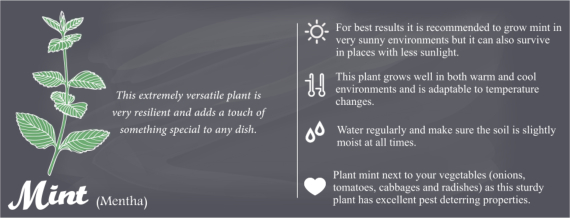
Mint
Getting the conditions just right
Herbs are, in general, not too fussy. They will grow in most places, making them ideal for small gardens or kitchens. Some herbs, such as basil, tend to prefer a good amount of sunlight so it is recommended that your herb garden is orientated south and west. Also make sure your plants get 4-6 hours of sunlight every day in order for them to grow and thrive.
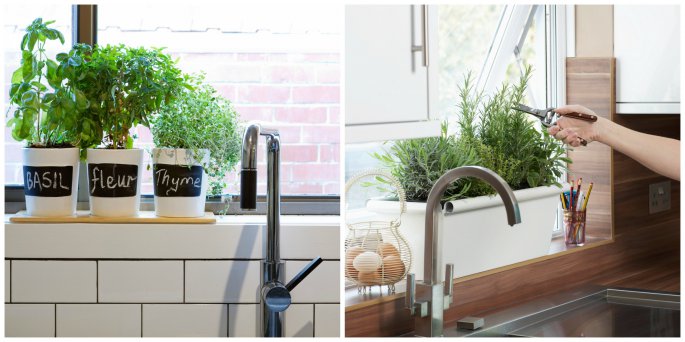
Growing Herbs In The Kitchen
If space is an issue consider gardening vertically. Vertical gardens have become really popular alternatives for people with small gardens or no garden at all because they allow you to grow a variety of plants in a very small space. Plus, they look great, too!
There are several approaches to vertical gardening such as using pallets or raised flower beds. Pallets are great because if you place them on a wall or fence outside they will keep your plants away from pests that might harm them such as slugs and snails.
Another advantage of vertical gardens is that they are relatively low maintenance. By grouping plants that have similar watering needs (parsley alongside basil for example) you can easily organise watering and care for your herbs. If you plan on using a pallet for your vertical garden we suggest placing the plants that require the most watering at the bottom and the more drought-resistant ones at the very top.
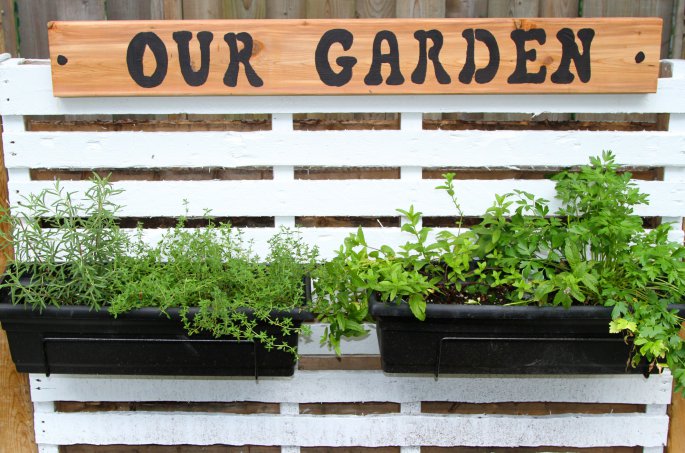
Vertical Palet Garden
Raised flower beds are also a great, low-maintenance option. They add a dynamic touch to your garden and can make a small garden appear less messy. If you plan on growing your herbs indoors, placing them in individual pots on a windowsill can perfectly complement a modern kitchen décor and make it look brighter and more inviting.
To help you remember these useful tips on how you can master growing herbs we created a really handy infographic below.

Herbs Infographic
We would love to hear your experiences with growing herbs both in your garden and in your home. Let us know what your favourite plants are as well as any top tips you have on how to make them thrive in your home. We'd love to hear from you!









